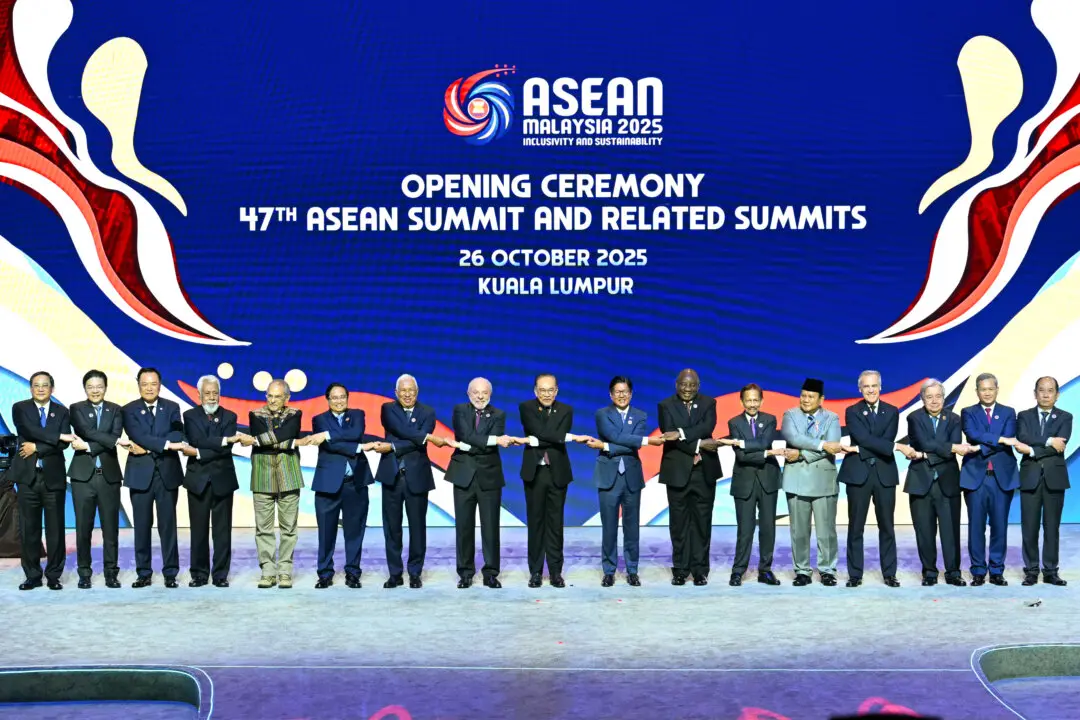
World leaders pose for a photo during the opening ceremony of the 47th ASEAN Summit in Kuala Lumpur, Malaysia, on Oct. 26, 2025. Mohd Rasfan/AFP via Getty Images
News Analysis
The new Liberal government signalled this summer that changes were afoot in how it manages relationships in Asia, and this has materialized more recently in a significant way, as Ottawa pursues “pragmatic” policies.
In short, sizeable contentious issues are being fenced off in order to benefit from the economic opportunities offered by the world’s two most populous countries: China and India.
Canada’s relations with the two countries crashed in recent years, due to key incidents and both of them being seen by Ottawa as a source of foreign interference and transnational repression.
The government of Prime Minister Mark Carney is not letting these concerns impact a diplomatic reset, as it aggressively seeks to boost foreign trade to diversify away from the United States.
Meetings at the highest level have relaunched the relationships. Carney met with his Indian counterpart Narendra Modi in Canada in June, and with Chinese leader Xi Jinping in South Korea on Oct. 31.
Following the meeting with Xi, Carney spoke of a “turning point” in the relationship with Beijing. Shortly after, China lifted its ban on group travel to Canada, reopening the doors to a windfall of tourism dollars.
Carney has yet to travel to India but has accepted an invitation from Xi to visit China.
Carney’s meeting with the Chinese leader followed Foreign Affairs Minister Anita Anand’s travel to China in mid-October, after which she said Ottawa is in a “strategic partnership” with Beijing.
“We must be nuanced in our diplomacy,” she told The Canadian Press in an interview after her trip. “We must stress our concerns relating to security and public safety on the one hand, and we must seek to build additional supply chains on the other. That is pragmatism.”
This re-engagement strategy focused on boosting trade in Asia is in the process of being drafted into formal government policy, Anand said in late October.
“What I’m saying to the department now is we need to update that Indo-Pacific strategy. It is not reflective of our economic ambitions in the region,” Anand said during an event held by the Canada 2020 think tank. The minister said access to Asian markets must translate into economic gains for Canada.
The Indo-Pacific Strategy was written after a breakdown in relations with China occurred in late 2018, when Canada executed a U.S. extradition warrant for Huawei executive Meng Wanzhou. China detained Canadians Michael Kovrig and Michael Spavor for more than 1,000 days in apparent retaliation.
The strategy calls China an “increasingly disruptive global power” that disregards international rules and whose values “increasingly depart from ours.”
Canada and China had agreed to a strategic partnership under the Paul Martin Liberals in 2005, and former Prime Minister Justin Trudeau initially pushed for stronger China ties after taking power in 2015, but the Meng Wanzhou affair changed Ottawa’s trajectory.
Carney’s Vision
After his meeting with Xi Jinping in South Korea, Carney was asked by reporters whether he agrees with Canada’s existing Indo-Pacific Strategy’s statement that China is disruptive.
He responded that there are different aspects of disruption, including in terms of China having market dominance in some areas like critical minerals or having overcapacity in steel production.
“That disruption that comes from China brings also opportunity,” he said, pointing to Canada’s wealth in critical minerals.
Carney added that his government is “clear-eyed” about issues in the Indo-Pacific. “From a geo-strategic perspective, we have pragmatic engagement with China, pragmatic engagement with China,” he said. “There are areas where we will engage and cooperate, and there’s others where, again, in a relationship, we can establish an ability to make our views known directly to them.”
Some of that entailed raising foreign interference concerns during the meeting with Xi, Carney told reporters when asked about Ottawa’s readout of the meeting not mentioning China’s foreign interference and transnational repression. “I don’t think they recognize the level of concerns we have about these issues,” the prime minister noted specifically with regard to the issue of foreign interference, without referencing the issue of human rights.
On areas of cooperation, like the previous Liberal government, Carney is looking to work with China on areas like climate change and net-zero initiatives.
After his meeting with Xi, he steered clear of signalling his intention regarding Ottawa’s 100 percent tariff on Chinese electric vehicles, which has been met by retaliation against Canada’s agricultural and seafood sectors.
He did mention, however, how one project identified by his government as being of “national interest” is an offshore wind farm in Nova Scotia. Carney said Chinese companies are some of the most competitive in that field, hence it’s a “natural potential area for cooperation.”
Meanwhile, areas like cyber cooperation is a “different issue,” Carney said, adding Canada has to be “clear” on where the Chinese are.
The Cyber Centre, within Communications Security Establishment Canada (CSE), Canada’s agency responsible for cyber security and foreign signals intelligence, calls China the “most sophisticated and active state cyber threat to Canada today.”
Michael Kovrig, the former Canadian diplomat detained for nearly three years in China, has warned in recent weeks about the risks of putting China at the core of Canada’s trade diversification strategy and of focusing on climate issues as a way to find common ground.
“As it’s demonstrated time and again, if you create dependency on China, it will weaponize it for political purposes and to silence Canada and constrain our foreign policy,” he told CTV News this week. In September, he told CTV that Canada can’t count on China not to use “green technology or climate change as a point of leverage for something else they get.”
Change of Tone
Carney’s weighted words to describe China and its actions, along with Anand calling the relationship a “strategic partnership,” have now replaced his previous tone.
Conservatives have criticized this change, noting how the discourse was different during the election.
At the time of the election campaign and shortly after, Carney had made several comments critical of China.
During the leaders’ debate in April, when asked what is the “biggest security threat” facing Canada, Carney answered “China.”
Days earlier, he had said that Canada needed to diversify its trade with “like-minded partners” like the Europeans and others in Asia. “But the partners in Asia that share our values don’t include China,” he said.
Carney did not close the door entirely, however, as he pointed out that Canada does a significant amount of trade with China. “But we have to be very careful, very deliberate, and they need to meet Canadian standards.”
After winning the election, Carney met with U.S. President Donald Trump at the White House in May and called him a “transformational” leader. Later, when asked by reporters in what positive way Trump has been transformational, Carney pointed to his approach toward China.
“He’s been clearer on risks involving geopolitical competition from China,” Carney said. Trump since his first term has taken different actions, including imposing tariffs, to deal with China and has made deterring war with the Asian nuclear power the U.S. military’s priority.
Military Moves
Carney’s government has not signalled a similar military intention, nor would it have the capacity, but it is significantly increasing defence expenditures to grow and re-arm the Canadian Armed Forces.
In the Indo-Pacific, Ottawa is also building military partnerships with China’s neighbours. During the visit of Indonesian President Prabowo Subianto to Ottawa in September, Carney announced the signing of a defence cooperation agreement with the Southeast Asian country.
This was followed by Defence Minister David McGuinty’s visit to the Philippines earlier this month and an agreement signed with his Filipino counterpart to deepen military cooperation.
The Philippines and other Southeast Asian countries have been involved in long-standing territorial disputes with China in the South China Sea. One recent incident in October involved a Chinese coast guard ship ramming a Philippine government vessel near Thitu Island, part of the Spratly Islands, which are disputed among several Southeast Asian states.
Ottawa’s Indo-Pacific Strategy calls out China on the matter, saying that it has disregarded United Nations rulings on disputes in the area and that its militarization in the region poses a challenge to navigation and overflight rights.
Critical Minerals
The Indo-Pacific Strategy also highlights the importance of critical minerals and the role Canada can play in supplying Asian partners such as Japan and South Korea.
China has been a dominant producer of rare-earth minerals used to manufacture communications and defence equipment, and it has leveraged this asset in its trade conflict with the United States by threatening to shut off supply.
In a bid to reduce this dependency, Ottawa has expressed interest in recent years in developing and increasing Canada’s capacity to mine and process the minerals, and the Carney Liberals have taken additional steps in recent months.
This includes the launch of the G7 Critical Minerals Action Plan and the Critical Minerals Production Alliance in June, when Canada hosted the group’s summit. Energy Minister Tim Hodgson announced the first round of projects under the alliance on Oct. 31, with the plan to unlock and speed up $6.4 billion of critical minerals projects.
Budget 2025 also has a number of measures to help develop the critical minerals industry in Canada, including allocating $2 billion over five years in a Critical Minerals Sovereign Fund to invest in projects.
The Canadian Press contributed to this report.
Noé Chartier is a senior reporter with the Canadian edition of The Epoch Times. Twitter: @NChartierET
